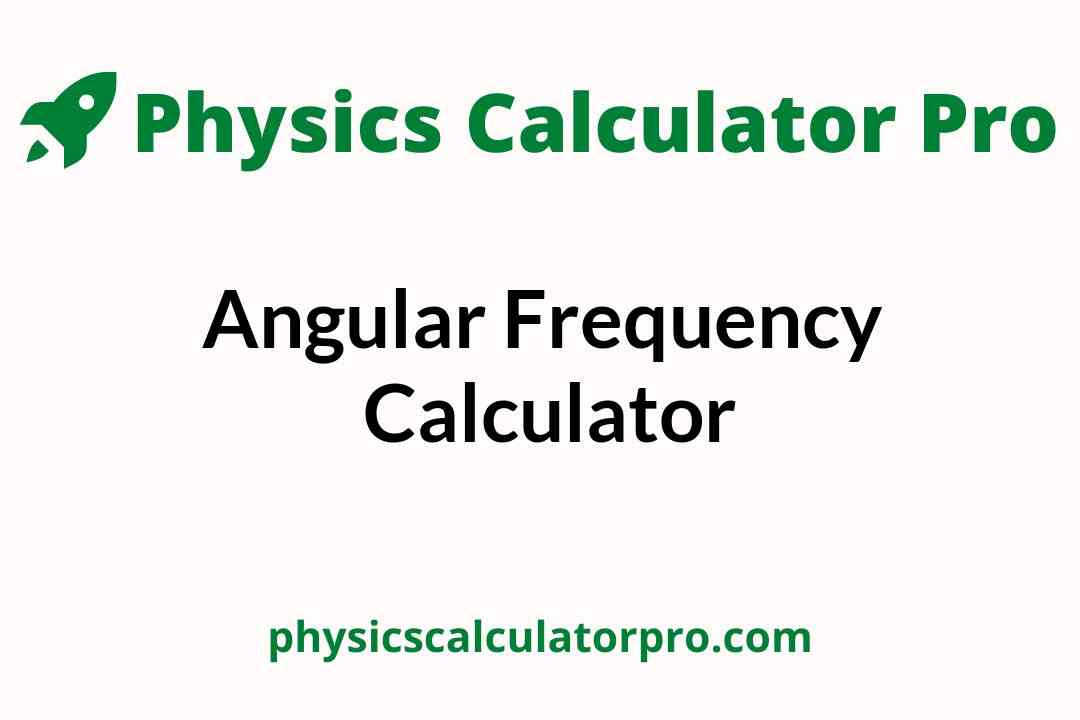Angular Frequency Calculator
The angular frequency calculator will assist you in calculating a system's angular frequency (also called angular velocity). We illustrate several angular frequency formulae and explain how to compute the angular frequency for simple harmonic motion and rotatory motion in the article below.
What is meant by Angular Frequency?
The angular frequency of an object is a scalar physical parameter that indicates how quickly it spins or oscillates in relation to time. The Greek letters Ω or ω are commonly used to represent it. We use the SI unit of radians per second, or rpm (revolutions per minute), to measure it. It is a factor of 2π that differs from frequency.
How can you find out a rotating object's angular frequency?
For rotating objects, the basic angular frequency equation can be used:
ω = Δθ / Δt
- Where:
- Δθ - The amount of rotation, measured in radians; and
- Δt - Time is measured in seconds.
For example;
The wheel revolves 200 radians in 40 seconds then, How do you determine the angular velocity of a wheel?
Solution: ω = 200 radians / 40 seconds
ω = 5 rad/s
How does the angular frequency of a simple harmonic motion be calculated?
In this situation, the angular frequency equation for oscillating objects should be used, which is: ω = 2 * π * f = 2 * π / T
- Where:
- f - Frequency;
- T - Time period; and
π - Pi, a mathematical constant with a value of 3.142 that is defined as the ratio of a circle's circumference to diameter. (In the realm of mathematics, it's something of a celebrity.)
For example;
How do you find the angular frequency in the instance of a pendulum that oscillates at a frequency of 2 Hz?
Solution:
ω = 2 * 3.142 * 2 rad/s
ω = 12.566 rad/s
How do I use the angular frequency calculator?
The following is the procedure how to use the angular frequency calculator:
1. Recognize the appropriate formula.
Is there a wheel-like motion to the object? Is it a swing set that moves back and forth? Although both of these motions have an angular frequency, we calculate it differently. Decide which angular frequency formula to apply depending on the situation. Use the section labelled "Spin" for spinning or rotating things. Use the second section, For spinning and oscillating objects, for rotating objects and oscillations.
2. Make a list of all the known variables and their values.
Examine what you have and don't have. Because the method for calculating angular velocity is linear, rearranging it should be straightforward.
3. Ensure that you're using the correct units.
One of the most common errors students (and teachers) make is failing to utilise the proper units. Always double-check your variables' units. To change units, use the dropdown option at the bottom of the input field.
4. Fill in the blanks.
Fill in the blanks with the values you choose, and you're done! You'll find your solution in the Angular Frequency box. Isn't it amazing?
5. Reverse the calculator's operation.
Do you already know how to calculate angular frequency and wish to calculate something else? That's something else this calculator can do! To compute other variables, simply enter the value in the box labeled Angular frequency.
Find similar concepts related to physics all under one roof at Physicscalculatorpro.com and resolve all your doubts as a part of your homework or assignment.
FAQs on Angular Frequency Calculator
1. What is the angular frequency?
The frequency of a periodic process (such as an electric oscillation or a sound vibration) is represented in radians per second, which is equal to the frequency in cycles multiplied by 2π.
2. What is the formula for calculating angular frequency?
ω = 2π/T is used to calculate the angular frequency. In radians per second, the angular frequency is measured. The frequency f = 1/T is the inverse of the period. The number of complete oscillations per unit time is determined by the motion's frequency, f = 1/T = ω/2π.
3. What is the formula for converting frequency to angular frequency?
The frequency of angular movement per unit time is measured by angular frequency (also known as radial or circular frequency). As a result, its units are degrees (or radians) per second. As a result, 1 Hz equals 6.28 rad/sec. Because 2 radians equal 360 °, 1 radian equals 57.3°.
4. Is there a difference between angular frequency and angular velocity?
They use different units to quantify the same thing (rate of rotation). The frequency is simply the number of revolutions per unit of time, whereas the angular velocity is the rate at which the angle (typically measured in radians) varies.
5. How do you determine a circuit's angular frequency?
The word angular frequency refers to the rate at which the waveform changes per unit of time. It is denoted by the sign ω and is measured in rad/s. The formula for angular frequency is ω = 2πf.
